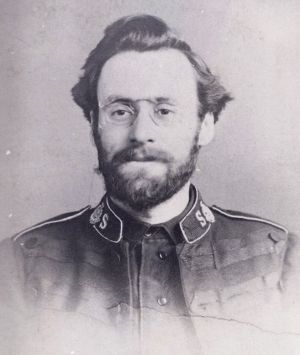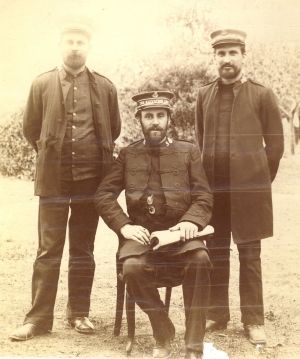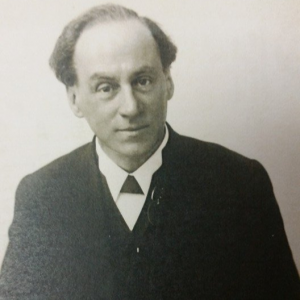Commandant Herbert - Australia's adopted Booth
.png)
Commandant Herbert - Australia's adopted Booth
(Top row from left) Herbert and Cornelie Booth c.1896, Commandant Herbert Booth: Territorial Commander Australasian Territory (1896-1901). (Bottom row from left) Herbert and Cornelie Booth with General William Booth in Western Australia in 1899, a young Herbert with his sisters Evangeline and Emma Booth.
As the son of Salvation Army co-founder General William Booth, Herbert Henry Howard Booth lived with a spiritual mantle few can comprehend. Well-loved in the Australasian Territory due to his innovative leadership as Commandant from 1896 to 1901, behind the scenes, Herbert struggled with familial relationships and eventually resigned from his position. Others Online gives us a snapshot of this fascinating man’s life – and reveals just how much he shaped the Australia Territory we know today.
 Herbert Henry Howard Booth led the Australiasian Territory from 1896 to 1901 and was known for his aristocratic tendencies. His innovation in screenwriting, film and other creative endeavours drove the territory forward and influenced the international Army in its early years.
Herbert Henry Howard Booth led the Australiasian Territory from 1896 to 1901 and was known for his aristocratic tendencies. His innovation in screenwriting, film and other creative endeavours drove the territory forward and influenced the international Army in its early years.
Herbert Henry Howard Booth was born on 26 August 1862 at Penzance in Cornwall, England. He was the youngest and most artistically creative of William and Catherine Booth’s sons, and the fifth of their eight children.
As with his siblings, Herbert was a leader of Salvation Army work from an early age. In 1884, he was principal of the Men’s Training Home in the United Kingdom, later commanding the Army’s work in ‘The British Isles’ and then in Canada.
Herbert’s relationships with the General (his father William) and the Chief of the Staff (big brother Bramwell) deteriorated somewhat following the death of his mother Catherine in 1890. There was also the departure from the Army of his brother Ballington; sister Kate followed Ballington and Herbert out of the Army, leaving a year after Herbert. Herbert was a Booth, and a man of his times; he was a talented, imperious autocrat who welcomed no encumbrance to his efforts.
Appointed to lead the Australasia Territory and arriving in Melbourne on 25 August 1896, 34-year-old Herbert, with his wife Cornelie and their young family, got stuck in and worked at a fever pitch until Herbert left the work in 1902. Feeling hemmed in by new rules and regulations from the UK, and slighted by his father, Herbert’s resignation letter was signed by “your brokenhearted son and daughter”.
In the five years he led Salvationists Down Under, Herbert was busy. An ardent supporter of national unity, he created and sent the Army’s Federal Band and the Federal Choristers to tour Australia, “proclaiming the Gospel and promoting Federation”. The ‘Move On Manifesto’ he introduced was a detailed, strategic plan to help implement General Booth’s ‘In Darkest England’ scheme, and build up the Army’s social work in Australia. He founded a national training college for officers in East Melbourne and grew the War Cry into a 16-page national newspaper (self-printed).
 Commandant Herbert Booth (seated) with Western Australia Salvationists during a visit to Collie in 1899.
Commandant Herbert Booth (seated) with Western Australia Salvationists during a visit to Collie in 1899.
Herbert oversaw the Army’s recording of the unprecedented film documentary of the 1901 Australian Federation ceremonies in Sydney and Melbourne.
The Australia Territory’s Museum Manager Lindsay Cox has noted it was the new nation’s first feature-length documentary, the first use of multi-camera coverage, and the most widely distributed Australian film of its time.
Herbert also masterminded productions such as the seminal multimedia production Soldiers of the Cross, which featured the early and influential use of narrative drama captured on film.
Herbert’s creativity was fulfilled through his fervent support and use of filmmaking as a means of both communicating the Army’s message and fundraising for its social and evangelical work. Significantly, Herbert expanded the Army’s Limelight Department to the point where the Salvationists had produced some 300 films, and 20 teams were touring locations in Australia and New Zealand at any given point.
Herbert is particularly remembered and loved by Salvationists as a prolific and talented songwriter. He pushed holistic mission. He mobilised Salvationists to work towards a common purpose – witnessing to and serving a widespread, soon-to-be nation, by championing the federation of Australia.
 Ambassador Herbert Booth, post-Salvation Army officership. Herbert would continue to evangelise for the rest of his life.
Ambassador Herbert Booth, post-Salvation Army officership. Herbert would continue to evangelise for the rest of his life.
Through ‘Cavalry forts’ (horse-drawn caravans), ‘Salvation riders’ (horse evangelists), boats and bicycle brigades, Herbert had Salvos reaching any and every settlement. He also started the Hamodava Tea Company, a forerunner of the Fair Trade movement. Significantly, Herbert’s support of and fundraising for Salvation Army social work in this country can be said to have served as an inspiration internationally.
Early in 1901, the emotional toll on Herbert from his strained relations with his father and Bramwell became intolerable. He decided he needed a complete break from high command, but while taking leave at a Salvation Army property on the Collie River in Western Australia, he and his wife decided to leave the Army.
He knew he would be ostracised by the family, as he wasn’t the first Booth to resign. And there were sorrow and hard feelings at the time from many colleagues – Commissioner James Hay even had Herbert’s name removed from foundation stones and building plaques [some were later restored].
Herbert and Cornelie desired a new life and set sail for San Francisco in August 1902. Cornelie was promoted to glory in 1920, and three years later Herbert married Australian Salvationist Annie Lane, who was from Orange (NSW).
Herbert was promoted to glory in New York, aged 64, on 25 September 1926, having spent the rest of his life as an evangelist, using the Soldiers of the Cross film in crusades across the US, Canada, England, New Zealand and Australia until it literally wore out.